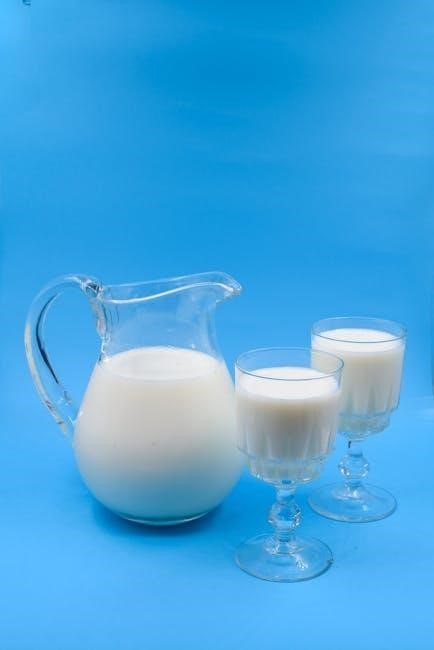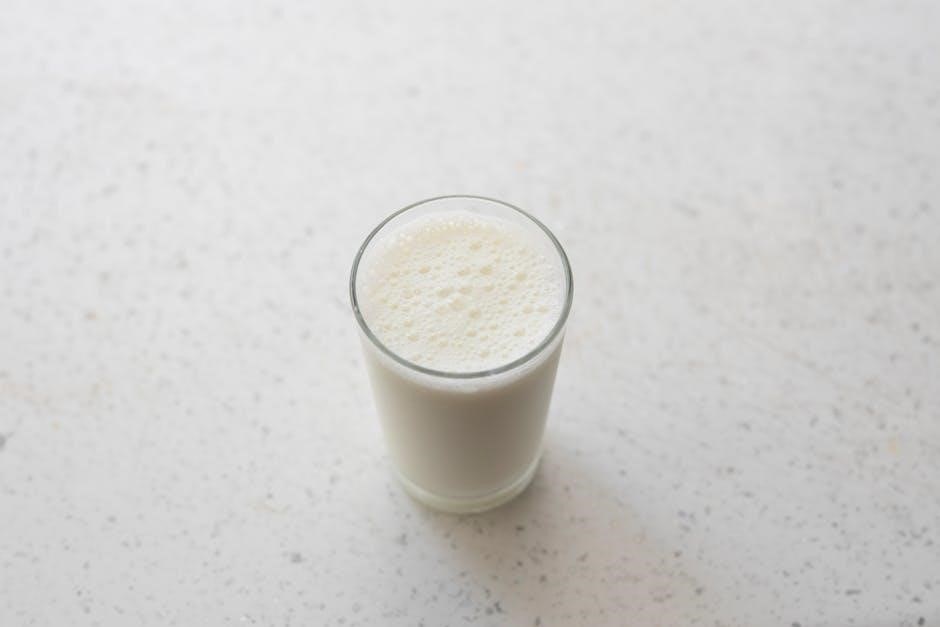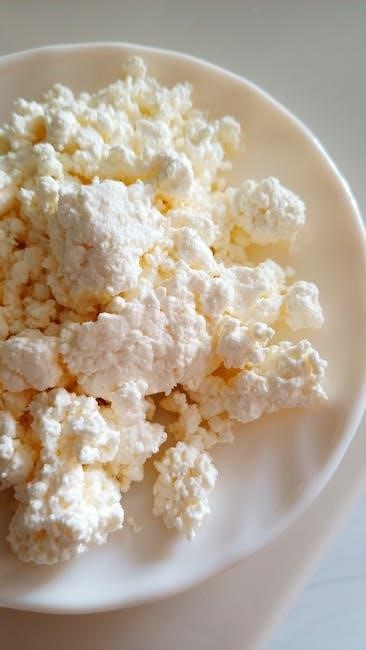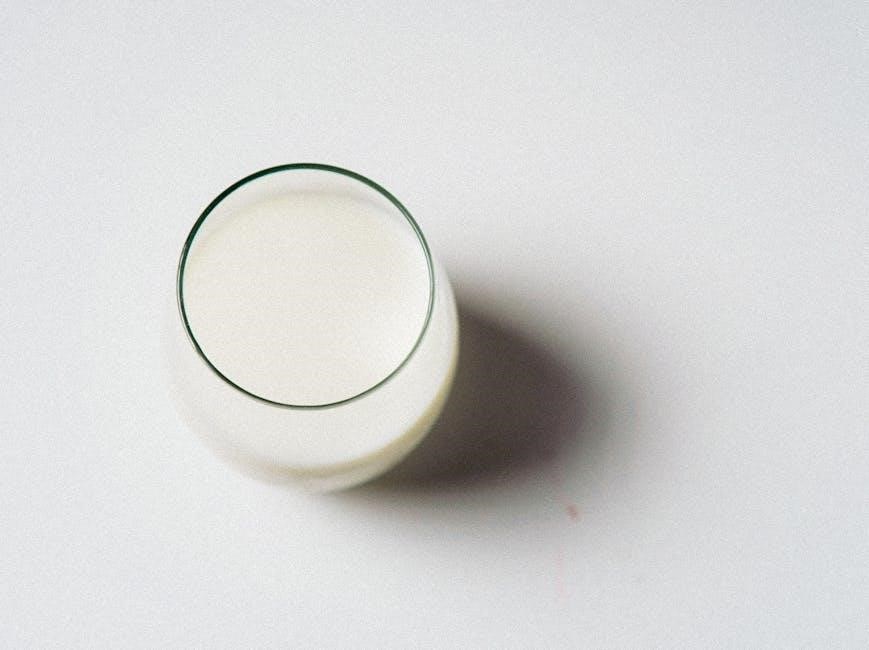Lactose intolerance is a common condition where individuals struggle to digest lactose‚ a sugar found in dairy products‚ due to low levels of the enzyme lactase.
A tailored lactose intolerance diet plan helps manage symptoms like bloating and digestive discomfort while ensuring essential nutrients are maintained for overall health and well-being.
Definition of Lactose Intolerance
Lactose intolerance is a condition where the body cannot properly digest lactose‚ a sugar found in milk and other dairy products. This occurs due to a deficiency of lactase‚ the enzyme responsible for breaking down lactose into easily absorbed sugars.
It is not a food allergy but a digestive issue‚ leading to symptoms like bloating‚ gas‚ and diarrhea after consuming lactose-containing foods. The severity varies among individuals‚ with some tolerating small amounts without discomfort.
Prevalence of Lactose Intolerance Globally
Lactose intolerance is a widespread condition affecting millions worldwide‚ with varying prevalence across different regions and populations.
It is most common in areas where lactase non-persistence is prevalent‚ such as in many Asian‚ African‚ and Latin American countries‚ due to lower levels of the lactase enzyme.
Genetic factors play a significant role in its global distribution‚ with certain ethnic groups being more prone to lactose malabsorption.
Understanding its prevalence helps in developing targeted dietary strategies to manage symptoms and improve quality of life for those affected.
Importance of a Lactose Intolerance Diet Plan
A well-structured lactose intolerance diet plan is crucial for managing symptoms and preventing nutrient deficiencies‚ ensuring optimal health.
It helps individuals avoid discomfort caused by lactose consumption while maintaining a balanced intake of essential nutrients like calcium and vitamin D.
By identifying lactose-containing foods and exploring alternatives‚ individuals can enjoy a varied and nutritious diet without compromising their dietary needs or overall well-being.

Understanding Lactose Intolerance
Lactose intolerance is a common condition where the body struggles to digest lactose‚ a sugar in dairy products‚ due to low levels of the enzyme lactase.
Causes of Lactose Intolerance
Lactose intolerance occurs when the body lacks sufficient lactase‚ an enzyme that breaks down lactose in dairy products. This deficiency is often genetic‚ with certain populations more prone to it. Some individuals develop intolerance after gastrointestinal infections or injuries that damage the small intestine. Additionally‚ premature infants may temporarily struggle with lactose digestion. The inability to digest lactose leads to undigested sugars fermenting in the colon‚ causing symptoms like bloating‚ gas‚ and diarrhea. Understanding these causes is crucial for developing an effective lactose intolerance diet plan.
Symptoms of Lactose Intolerance
Symptoms of lactose intolerance typically appear 30 minutes to 2 hours after consuming lactose-containing foods. Common symptoms include bloating‚ gas‚ diarrhea‚ and stomach cramps. Some individuals may also experience nausea or vomiting. The severity of these symptoms varies depending on the amount of lactose consumed and the individual’s level of lactase deficiency. Mild cases may cause minimal discomfort‚ while larger amounts of lactose can lead to more pronounced and debilitating symptoms. Recognizing these symptoms is essential for diagnosing lactose intolerance and adapting a suitable diet plan to alleviate discomfort.
How Lactose Intolerance is Diagnosed
Lactose intolerance is typically diagnosed through a combination of clinical evaluation‚ dietary assessment‚ and specific tests. The hydrogen breath test measures levels of hydrogen in the breath‚ which increases if undigested lactose ferments in the colon. A lactose tolerance test involves consuming a lactose solution and measuring blood sugar levels to assess digestion. Symptoms such as bloating‚ gas‚ and diarrhea after consuming lactose-containing foods often prompt further testing. These methods help confirm the presence and severity of lactose intolerance‚ guiding the development of an appropriate diet plan.

Dietary Management of Lactose Intolerance
Managing lactose intolerance involves avoiding high-lactose foods‚ using lactase supplements‚ and choosing low-lactose or non-dairy alternatives to maintain proper nutrition and digestive comfort effectively.
Basics of a Lactose-Free Diet
A lactose-free diet focuses on eliminating or reducing lactose intake to alleviate symptoms like bloating and diarrhea. It emphasizes avoiding dairy products high in lactose‚ such as milk‚ cheese‚ and ice cream. Individuals can opt for lactose-free or low-lactose alternatives‚ like hard cheeses or fermented products‚ which are easier to digest. Additionally‚ non-dairy options such as almond‚ soy‚ or oat milk are excellent substitutes. Reading food labels carefully is crucial to identify hidden lactose in processed foods. This dietary approach helps manage symptoms while ensuring nutrient intake remains balanced and adequate for overall health.
How to Read Food Labels for Hidden Lactose
Reading food labels is essential for identifying hidden lactose in processed foods. Look for ingredients like milk‚ lactose‚ whey‚ casein‚ and milk solids‚ as these indicate lactose presence. Even non-dairy products‚ such as bread‚ cereals‚ and snacks‚ may contain hidden lactose. Choose products labeled as “lactose-free” or “dairy-free” to ensure safety. Pay attention to certifications like the “LF” label‚ which confirms low lactose content. This careful approach helps avoid accidental lactose consumption and supports effective dietary management for those with lactose intolerance.
Managing Hidden Sources of Lactose
Hidden lactose is often found in processed foods‚ medications‚ and non-dairy products. To manage this‚ thoroughly check food labels for milk-derived ingredients like whey‚ casein‚ and lactose. Opt for certified lactose-free or dairy-free alternatives. When dining out‚ inform servers of lactose intolerance to avoid unintentional exposure. Additionally‚ consider using lactase supplements before consuming small amounts of lactose-containing foods. Being vigilant and proactive helps minimize discomfort and ensures a balanced diet while managing lactose intolerance effectively over time.

Food Choices for a Lactose Intolerance Diet
Focus on low-lactose or lactose-free alternatives‚ such as non-dairy milk and cheese. Include naturally lactose-free foods like fruits‚ vegetables‚ nuts‚ and lean proteins for a balanced diet.
Foods to Avoid: High Lactose Content
- Dairy products like whole milk‚ cheese‚ and ice cream are high in lactose.
- Soft cheeses‚ such as brie and mozzarella‚ contain higher lactose levels.
- Butter‚ cream‚ and yogurt (especially non-probiotic) should be avoided.
- Hidden lactose in processed foods‚ baked goods‚ and some medications.
Avoiding these foods helps prevent symptoms like bloating and diarrhea in lactose intolerant individuals;

Foods to Include: Low Lactose or Lactose-Free Alternatives
- Low-lactose milk‚ aged cheeses‚ and probiotic yogurt are easier to digest.
- Lactose-free dairy products‚ such as milk and ice cream‚ are excellent alternatives.
- Non-dairy milk options like almond‚ soy‚ and oat milk are lactose-free.
- Naturally lactose-free foods‚ including fruits‚ vegetables‚ and whole grains‚ are ideal.
Incorporating these foods ensures a balanced diet while managing lactose intolerance symptoms effectively.
Naturally Lactose-Free Foods
- Fresh fruits‚ vegetables‚ and whole grains are inherently lactose-free and rich in essential nutrients.
- Nuts‚ seeds‚ and legumes provide protein and fiber without lactose.
- Lean meats‚ poultry‚ fish‚ and eggs are excellent protein sources that naturally lack lactose.
- Healthy fats like avocados‚ olive oil‚ and coconut oil are also lactose-free.
These foods are ideal for a lactose intolerance diet‚ offering variety and ensuring a balanced intake of nutrients without dairy products.

Dairy Products and Lactose Intolerance
Dairy products naturally contain lactose‚ making them a primary concern for those with lactose intolerance. Limiting or avoiding these products is often necessary to manage symptoms effectively.
Understanding Lactose in Dairy Products
Lactose is a naturally occurring sugar found in milk and dairy products like cheese‚ yogurt‚ and ice cream. Its concentration varies depending on the type of dairy product. For instance‚ milk contains higher lactose levels‚ while fermented products like cheese and yogurt have lower amounts due to lactose being broken down during fermentation. Understanding lactose levels in dairy products is crucial for managing lactose intolerance‚ as it helps individuals make informed choices about which products to consume or avoid. This knowledge also aids in identifying suitable alternatives for those with dietary restrictions.
Low-Lactose or Lactose-Free Dairy Options
For those managing lactose intolerance‚ low-lactose or lactose-free dairy products are excellent alternatives. Hard cheeses like cheddar and Swiss naturally contain less lactose‚ while soft cheeses may have higher amounts. Fermented products like yogurt‚ especially those with live cultures‚ can be easier to digest. Additionally‚ lactose-free milk and ice cream are widely available‚ treated with lactase to break down lactose. These options allow individuals to enjoy dairy without discomfort‚ ensuring they can still benefit from essential nutrients like calcium and vitamin D while adhering to their dietary needs.
Non-Dairy Alternatives to Milk and Cheese
Non-dairy alternatives provide excellent options for those avoiding lactose. Plant-based milks like almond‚ soy‚ oat‚ and coconut milk are naturally lactose-free and often fortified with calcium and vitamins. These products can easily replace traditional milk in recipes and daily consumption. Additionally‚ vegan cheeses made from nuts‚ seeds‚ and soy offer versatile substitutes for dairy cheese‚ catering to various tastes and textures while ensuring a lactose-free diet remains flavorful and satisfying.

Meal Planning for Lactose Intolerance
Meal planning for lactose intolerance involves creating a balanced diet with lactose-free alternatives‚ ensuring proper nutrition while avoiding discomfort. Plan includes breakfast‚ lunch‚ dinner‚ and snacks tailored to individual tolerance levels‚ focusing on low-lactose or lactose-free options and hidden lactose sources. Adjust portion sizes and food choices to minimize symptoms‚ while exploring flavorful substitutes to maintain dietary variety and satisfaction. This structured approach helps manage lactose intolerance effectively without compromising on taste or nutritional value.
Sample Meal Plan for a Day
A sample meal plan for lactose intolerance might include lactose-free milk or almond milk for breakfast‚ paired with oatmeal or toast. Lunch could feature grilled chicken or fish with steamed vegetables and quinoa. Dinner might include lactose-free cheese in a pasta dish or a stir-fry with tofu. Snacks like fruits‚ nuts‚ or lactose-free yogurt are ideal. This plan ensures balanced nutrition while avoiding discomfort‚ offering a variety of flavors and textures to meet dietary needs and preferences.
Breakfast‚ Lunch‚ and Dinner Ideas
Start your day with lactose-free milk over cereal or a fruit smoothie with non-dairy yogurt. For lunch‚ opt for a turkey or chicken wrap with avocado and dairy-free spread‚ or a hearty salad with olive oil dressing. Dinner could feature lactose-free cheese in pasta‚ baked fish with herbs‚ or a stir-fry with tofu and mixed vegetables. These ideas ensure a balanced‚ flavorful diet while avoiding lactose‚ keeping meals enjoyable and nutritious for those managing lactose intolerance.
Snack Options for Lactose Intolerance
Snacking with lactose intolerance is easy with options like fresh fruits‚ nuts‚ and seeds. Enjoy lactose-free milk‚ dark chocolate‚ or dairy-free yogurt for sweet treats. Rice cakes with dairy-free spreads or homemade trail mix with dried fruits and nuts are great portable choices. Veggie sticks with hummus or guacamole also make satisfying snacks. These options ensure variety and nutrition while avoiding lactose‚ keeping energy levels steady throughout the day without discomfort.

Recipes for a Lactose Intolerance Diet
Discover delicious and easy-to-make recipes tailored for lactose intolerance‚ using lactose-free ingredients and alternatives to enjoy meals without compromising on taste or nutrition.
Breakfast Recipes Without Lactose
Start your day with nutritious and delicious lactose-free breakfast options. Try lactose-free milk or almond milk-based smoothies with fresh fruits and nuts. Oatmeal with coconut milk and berries is another great choice. Scrambled eggs with spinach or avocado toast are perfect dairy-free alternatives. Chia pudding made with plant-based milk and topped with granola and fruit is both healthy and tasty. These recipes ensure a balanced start without compromising on flavor or nutrition‚ keeping your mornings enjoyable and symptom-free.
Lunch and Dinner Recipes
Enjoy delicious and satisfying lactose-free meals with these recipes. For lunch‚ try a grilled chicken salad with mixed greens‚ avocado‚ and a citrus vinaigrette‚ or opt for a hearty quinoa bowl with roasted vegetables. Dinner options include baked salmon with lemon and herbs‚ served alongside steamed asparagus and brown rice. Stir-fries with tofu‚ veggies‚ and soy sauce are also great. Use olive oil‚ garlic‚ and herbs for flavor instead of dairy. These recipes are easy to prepare and cater to your dietary needs while ensuring a balanced and tasty meal.
Snacks and Desserts Suitable for Lactose Intolerance
Indulge in delicious snacks and desserts without compromising your dietary needs. Fresh fruits‚ nuts‚ and dark chocolate are excellent choices. For desserts‚ try lactose-free ice cream‚ sorbet‚ or fruit-based parfaits. Homemade options like almond flour cookies or coconut macaroons are also ideal. Ensure all store-bought treats are labeled as lactose-free or dairy-free. These snacks and desserts provide variety and satisfaction while adhering to your lactose intolerance diet plan‚ making it easy to enjoy treats without discomfort;

Tips for Managing Lactose Intolerance
Effectively managing lactose intolerance involves reducing symptoms by controlling portion sizes‚ using lactase supplements‚ and gradually introducing small amounts of lactose to tolerance levels.
Strategies for Eating Small Amounts of Lactose
Eating small amounts of lactose can be manageable by spreading lactose-containing foods throughout the day and choosing low-lactose options like hard cheeses or yogurt with live cultures.
Starting with minimal portions and gradually increasing tolerance helps the body adapt‚ while lactase supplements can aid digestion if needed.
Using Lactase Supplements
Lactase supplements can help individuals with lactose intolerance by breaking down lactose in foods before digestion begins.
Taking these supplements before meals containing dairy ensures proper nutrient absorption and reduces symptoms like bloating and discomfort.
They are particularly useful for occasional consumption of lactose-containing products‚ offering flexibility in dietary choices without compromising health.
Gradually Introducing Lactose into the Diet
Gradually introducing small amounts of lactose into the diet can help improve tolerance over time for some individuals.
Start with low-lactose foods‚ such as yogurt or cheese‚ and monitor for symptoms like bloating or discomfort.
Increasing lactose intake slowly allows the body to adapt‚ potentially reducing severity of symptoms over time.
This approach may help expand dietary options while minimizing discomfort for those with mild lactose intolerance.
Always consult a healthcare professional before making significant changes to your diet plan.
Nutritional Considerations
Maintaining adequate calcium and vitamin D intake is crucial for bone health‚ especially when dairy is limited or avoided in a lactose intolerance diet plan.
A balanced diet with nutrient-rich foods ensures proper absorption and prevents deficiencies while managing lactose intolerance effectively.
Maintaining Calcium and Vitamin D Intake
Maintaining adequate calcium and vitamin D levels is essential for bone health‚ especially on a lactose intolerance diet. Include calcium-rich foods like leafy greens‚ fortified plant-based milk‚ and tofu. Vitamin D can be obtained from sunlight‚ fatty fish‚ or supplements. Lactose-free or low-lactose dairy products‚ such as hard cheeses or yogurt with live cultures‚ can also contribute to calcium intake. Ensure a balanced diet to prevent deficiencies and support overall well-being while managing lactose intolerance effectively.
Ensuring Proper Nutrient Absorption
Ensuring proper nutrient absorption is crucial for individuals with lactose intolerance to avoid deficiencies. A balanced diet rich in fruits‚ vegetables‚ whole grains‚ and lean proteins helps maintain essential nutrients. Pairing lactose-containing foods with other foods can aid digestion. Incorporating lactase supplements or naturally lactose-free alternatives supports nutrient uptake. Regular meals and mindful portion control also enhance absorption‚ ensuring that dietary needs are met without discomfort‚ promoting overall health and well-being.
Avoiding Nutritional Deficiencies
Avoiding nutritional deficiencies is vital when managing lactose intolerance. Dairy products are key sources of calcium and vitamin D‚ so substitutes like fortified plant-based milks are essential. Including foods rich in these nutrients‚ such as leafy greens and fortified cereals‚ helps prevent deficiencies. Protein intake can be maintained through non-dairy sources like nuts‚ seeds‚ and legumes. Regularly reviewing and adjusting the diet ensures all nutritional needs are met‚ preventing long-term health issues related to inadequate nutrition.

Special Diets and Lactose Intolerance
Special diets‚ such as vegan‚ keto‚ or low-carb‚ can easily accommodate lactose intolerance by incorporating lactose-free alternatives‚ ensuring nutrient-rich meals without compromising dietary preferences or restrictions.
Dairy-Free Diets: Myths and Facts
Dairy-free diets are often misunderstood‚ with myths claiming they lack essential nutrients. In reality‚ dairy-free diets can be nutritionally complete by incorporating alternatives like almond milk and tofu. Many believe all dairy-free diets are strict‚ but some allow small amounts of lactose. Another myth is that dairy-free diets are boring‚ yet they offer diverse options like plant-based milks and cheeses. Facts show that dairy-free diets can effectively manage lactose intolerance while maintaining calcium and vitamin D intake through fortified products. Proper planning ensures nutritional balance and variety‚ debunking common misconceptions.
Vegan Diets for Lactose Intolerance
Vegan diets naturally exclude dairy‚ making them an ideal choice for managing lactose intolerance. Plant-based alternatives like almond‚ soy‚ and oat milk replace traditional dairy products. A well-planned vegan diet ensures essential nutrients‚ including calcium and vitamin D‚ through fortified foods and supplements. This approach eliminates lactose entirely‚ preventing discomfort and digestive issues. Vegan diets also promote a variety of nutrient-rich foods‚ such as fruits‚ vegetables‚ and whole grains‚ supporting overall health while addressing lactose intolerance effectively. Proper planning is key to maintaining nutritional balance and avoiding deficiencies.
Keto and Low-Carb Diets with Lactose Intolerance
Keto and low-carb diets can be adapted to accommodate lactose intolerance by carefully selecting dairy products. Hard cheeses like cheddar and Swiss naturally contain less lactose‚ making them suitable choices. Additionally‚ lactose-free or low-lactose alternatives can be incorporated to meet dietary needs without triggering symptoms; These diets emphasize high-fat‚ low-carbohydrate foods‚ which often overlap with lactose-free options. Proper planning ensures that individuals can follow a keto or low-carb lifestyle while managing lactose intolerance effectively‚ maintaining both digestive comfort and nutritional balance. This approach requires attention to food labels and ingredient sources to avoid hidden lactose.
Managing lactose intolerance requires a tailored diet plan‚ ensuring symptom relief while maintaining essential nutrients. Explore resources for recipes‚ meal ideas‚ and expert guidance to thrive lactose-free.
A well-structured lactose intolerance diet plan helps alleviate symptoms while ensuring nutrient-rich meals. Key strategies include avoiding high-lactose foods‚ incorporating lactose-free alternatives‚ and using lactase supplements. Many people can tolerate small amounts of lactose‚ varying by individual sensitivity. Prioritizing nutrient-dense foods like fruits‚ vegetables‚ and non-dairy calcium sources supports overall health. By understanding personal lactose limits and exploring dietary options‚ individuals can manage symptoms effectively and maintain a balanced diet without significant restrictions.
Recommended Resources for Further Reading
For further guidance on managing lactose intolerance‚ consult reputable sources like the Mayo Clinic‚ Healthline‚ or the Academy of Nutrition and Dietetics. Downloadable PDF guides‚ such as “Lactose Intolerance Diet Plan” by nutrition experts‚ offer practical meal ideas and tips. Additionally‚ books like “The Lactose-Free Diet” provide comprehensive strategies for symptom relief. Online forums and support groups‚ such as the Lactose Intolerance Support Group‚ can also offer shared experiences and advice from others managing the condition effectively.
Final Thoughts on Managing Lactose Intolerance
Effectively managing lactose intolerance requires a personalized approach‚ focusing on symptom relief while maintaining a balanced diet. Exploring low-lactose or lactose-free alternatives‚ gradual reintroduction of lactose‚ and using lactase supplements can enhance dietary flexibility. Education and planning are key‚ ensuring individuals can enjoy their favorite foods without discomfort. By adhering to a well-structured lactose intolerance diet plan‚ individuals can lead a healthy‚ symptom-free life while meeting their nutritional needs. Awareness and adaptation are crucial for long-term success in managing this condition.

No Responses